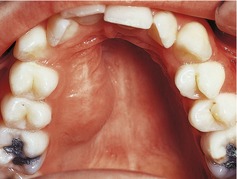Case• 55. A lump in the palate
SUMMARY
A 32-year-old lady is referred to your hospital oral and maxillofacial surgery department by her general dental practitioner because of a swelling in her palate. What is the cause and what treatment is appropriate?
History
Complaint
The patient has noticed a lump but has experienced no pain.
History of complaint
The patient thinks that the lump has been present for at least a year, possibly two. It has enlarged slowly and is now starting to be a nuisance.
Medical history
Her medical history reveals no illness. She has recently given up smoking but previously smoked two or three cigarettes a day.
Examination
Extraoral examination
She is a fit and well-looking woman. No cervical lymph nodes are palpable and the temporomandibular joints appear normal. There in no facial asymmetry.
Intraoral examination
The appearance of the palate is shown in Figure 55.1. There is a swelling of the right side of the palate and maxillary alveolus. There is no caries and only a few relatively small amalgam restorations.
▪ What are the features of the swelling?
The swelling has the following characteristics:
| Site | Molar to central incisor region |
| Size | 2 × 3 cm approximately |
| Shape | Oval |
| Surface | No ulceration |
| Colour |
Overlying mucosa normal. Has a slight blue tinge
No evidence of inflammation, not pointing
|
| Contour | Regular, rounded |
 |
| Fig. 55.1 |
If you were able to palpate the lesion and the patient’s neck you would discover the following:
| Lesion consistency | Firm, not fluctuant |
| Lesion mobility | Fixed |
| Cervical lymph nodes | No submandibular or cervical lymph nodes palpable |
Differential diagnosis
▪ On the basis of what you know so far, what types of lesion would you include in your differential diagnosis?
1. Benign neoplasm of palatal salivary gland, most probably a pleomorphic adenoma
2. Malignant salivary tumour, and if so:
— most probably a mucoepidermoid carcinoma, or
— polymorphous low grade adenocarcinoma,
— but possibly an adenoid cystic carcinoma
3. Odontogenic causes:
— either an abscess
— or an odontogenic cyst, probably a radicular cyst
4. Mucous retention cyst
5. Antral or nasal lesion bulging into the mouth (e.g. a carcinoma)
6. Miscellaneous other possibilities including lymphoma.
▪ Which of these possibilities are the most likely? Explain why.
Benign salivary gland neoplasm. The site of the swelling is compatible with a palatal salivary gland origin though it is slightly more anterior than is typical. Salivary glands are more numerous in the posterior hard palate or soft palate and a swelling level with or behind the molars would be more characteristic of a salivary gland origin. If the lesion is arising in a gland, then a neoplasm is the most likely cause of a long standing painless swelling. About half of minor gland neoplasms are benign and half malignant. By far the commonest single benign tumour is the pleomorphic adenoma and this is a very likely cause. Pleomorphic adenomas are commonest in middle and old age but have a wide age distribution and the young age of the patient need not exclude this poss/>
Stay updated, free dental videos. Join our Telegram channel

VIDEdental - Online dental courses


